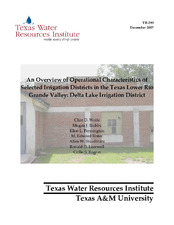An Overview of Operational Characteristics of Selected Irrigation Districts in the Texas Lower Rio Grande Valley: Delta Lake Irrigation District
Abstract
Population expansion and water shortfalls have placed the Texas Lower Rio Grande Valley (Valley) center stage in water publicity. The unique characteristics and lack of public knowledge on how irrigation districts divert and convey water from the Rio Grande to municipal, industrial, and agriculture consumers have precipitated questions regarding the operations and makeup of these districts. Differences between and similarities across irrigation districts can be partially attributed to the topography, water-delivery infrastructure system, past financial decisions, and population demographics and clientele base of each irrigation district. Delta Lake Irrigation District (DLID) is one of the 29 irrigation districts in the Valley. This study presents an overview of DLID that includes a brief historical background, a description of the District, and discussion of the District’s current operations. Specific information in the report details how the District diverts and delivers its allocated water from the Rio Grande, how it is used (i.e., municipal, industry, and agriculture), and mechanisms for allocation within and outside the District.
The uniqueness of the Lower Rio Grande Valley irrigation districts requires an understanding of their origins and operating mannerisms to explain their overall institutional effects. Through unlocking some of the conundrum associated with these individual irrigation districts, policymakers and other interested stakeholders will have a better perception of the culture and evolution that surround these unique districts, thereby facilitating improved policy-making decisions affecting the region’s water supply and usage.
Collections
Citation
Wolfe, Clint D.; Stubbs, Megan J.; Pennington, Ellen L.; Rister, M. Edward; Sturdivant, Allen W.; Lacewell, Ronald D.; Rogers, Callie S. (2007). An Overview of Operational Characteristics of Selected Irrigation Districts in the Texas Lower Rio Grande Valley: Delta Lake Irrigation District. Texas Water Resources Institute. Available electronically from https : / /hdl .handle .net /1969 .1 /86100.


